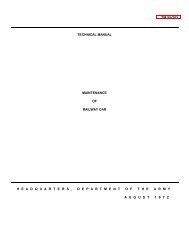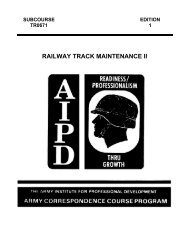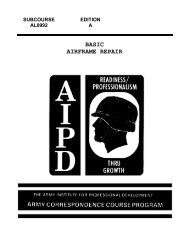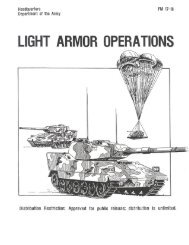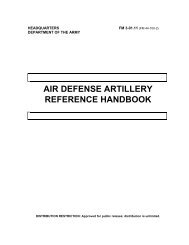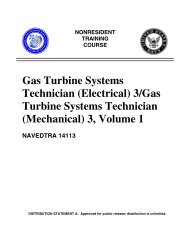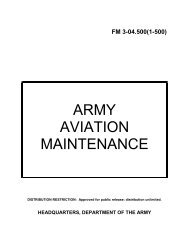fm 44-100 us army air and missile defense operations
fm 44-100 us army air and missile defense operations
fm 44-100 us army air and missile defense operations
You also want an ePaper? Increase the reach of your titles
YUMPU automatically turns print PDFs into web optimized ePapers that Google loves.
FM <strong>44</strong>-<strong>100</strong><br />
4-106. Army comm<strong>and</strong>ers normally seek to engage threat forces<br />
simultaneo<strong>us</strong>ly throughout the depth of the AO. The comm<strong>and</strong>er weights the<br />
main effort with sufficient, s<strong>us</strong>tained combat power to win the decisive<br />
battles <strong>and</strong> allocates enough combat power to supporting efforts to ensure<br />
overall victory. Force agility, initiative, <strong>and</strong> synchronized <strong>operations</strong><br />
throughout the width <strong>and</strong> depth of the battlefield characterizes ADA<br />
<strong>operations</strong>. Counter-RSTA <strong>and</strong> force protection remains crucial to the<br />
multinational, joint, <strong>and</strong> Army comm<strong>and</strong>ers' plans. Comm<strong>and</strong>ers conduct<br />
their <strong>operations</strong> with a sound logistical foundation integrated with their<br />
concept of combat <strong>operations</strong>. Countering helicopters increases in importance<br />
during the <strong>operations</strong> phase. Ensuring freedom to maneuver <strong>and</strong> minimizing<br />
casualties for the force are two of the primary objectives of <strong>air</strong> <strong>defense</strong>.<br />
4-107. ADA comm<strong>and</strong>ers m<strong>us</strong>t <strong>us</strong>e the same types of planning processes <strong>us</strong>ed<br />
by the supported force. This facilitates underst<strong>and</strong>ing <strong>and</strong> synchronization.<br />
Naturally the factors which go into the planning process for ADA units will<br />
be task organized to their mission <strong>and</strong> capabilities. ADA comm<strong>and</strong>ers <strong>us</strong>e<br />
employment principles <strong>and</strong> guidelines to design <strong>air</strong> <strong>and</strong> <strong>missile</strong> <strong>defense</strong>s.<br />
When applying these principles <strong>and</strong> guidelines, planners m<strong>us</strong>t consider the<br />
tactical <strong>and</strong> technical capabilities of each weapon <strong>and</strong> sensor system as well<br />
as the relevant factors of METT-TC, IPB, <strong>and</strong> the <strong>air</strong> <strong>and</strong> <strong>missile</strong> <strong>defense</strong><br />
priorities.<br />
Air Defense Artillery Employment Principles<br />
4-108. Comm<strong>and</strong>ers apply four principles when planning active <strong>air</strong> <strong>and</strong><br />
<strong>missile</strong> <strong>defense</strong> <strong>operations</strong>. These principles are mass, mix, mobility, <strong>and</strong><br />
integration.<br />
4-109. Mass is the concentration of <strong>air</strong> <strong>and</strong> <strong>missile</strong> <strong>defense</strong> combat power. It<br />
is achieved by assigning enough firepower to successfully defend the force or<br />
the asset against <strong>air</strong> <strong>and</strong> <strong>missile</strong> attack or surveillance. To mass <strong>air</strong> <strong>and</strong><br />
<strong>missile</strong> <strong>defense</strong> combat power, comm<strong>and</strong>ers may have to accept risks in other<br />
areas of the battlefield.<br />
4-110. Mix is the employment of a combination of weapon <strong>and</strong> sensor systems<br />
to protect the force <strong>and</strong> assets from the threat. Mix offsets the limitations of<br />
one system with the capabilities of another <strong>and</strong> complicates the situation for<br />
the attacker. All joint <strong>and</strong> multinational arms resources are considered when<br />
applying this principle. Proper mix ca<strong>us</strong>es the enemy to adj<strong>us</strong>t their tactics.<br />
Enemy tactics designed to defeat one system may make the enemy vulnerable<br />
to another friendly system.<br />
4-111. Mobility is the capability to move from place to place while retaining<br />
the ability to perform the <strong>air</strong> <strong>defense</strong> mission. The mobility of <strong>air</strong> <strong>and</strong> <strong>missile</strong><br />
<strong>defense</strong> resources m<strong>us</strong>t be equivalent to the mobility of the supported force.<br />
First priority for mobility should be planning moves that support<br />
accomplishment of the mission. Tactical situations may dictate additional<br />
moves to enhance survivability. Strategic mobility is essential to support<br />
force-projection <strong>operations</strong>.<br />
4-112. Integration is the close coordination of effort <strong>and</strong> unity of action,<br />
which maximizes operational effectiveness. It is applicable, regardless of<br />
comm<strong>and</strong> relationships established. Active <strong>air</strong> <strong>and</strong> <strong>missile</strong> <strong>defense</strong> <strong>operations</strong><br />
4-21




